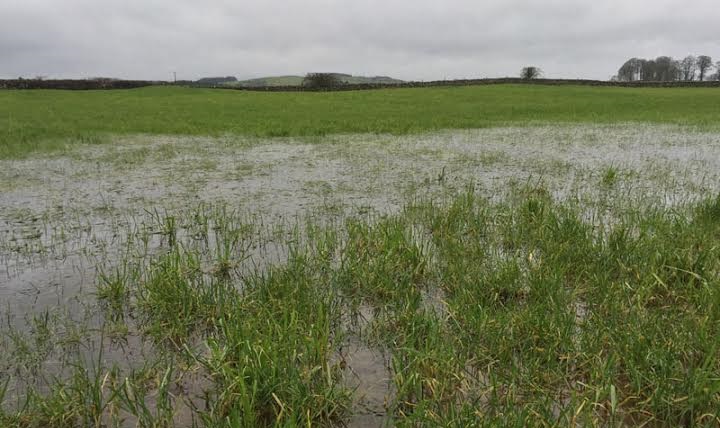
Winter 2015/16 has seen record temperatures and rainfall across the UK, and the unseasonably mild and wet weather has had a dramatic effect on pastures. To help farmers get flooded fields back to full fitness, and tackle grass that has grown all winter, Barenbrug UK has produced a list of top tips for getting swards back in shape.
This winter heavy storms have repeatedly battered the UK. The North West has been hit hard by large scale flooding with huge swathes of farmland waterlogged off and on since November. As a result, soil in many places has become compacted by the weight of the water lying on it. Valuable nutrients will also have been lost to leaching.
In other drier parts of the UK the weather has created different challenges. The mild temperatures experienced pre-Christmas meant that grass continued to grow. With no dormant period, swards have become very open. Low winter light levels also mean that any grass growth was weak – leaving plants fragile and susceptible to disease.
Mhairi Dawson, Research & Development Manager (Forage) at Barenbrug UK, said: “Weather wise, it’s been a very strange winter. One way or another our fields have had everything thrown at them. December was the warmest since records began in 1910 but also the wettest of any calendar month on record.
As a result, there is a question mark hanging over the productivity of a large percentage of pastures. Our advice to farmers across the UK is to tackle any problems head on – now ideally or as soon as conditions allow. For many farmers compaction is going to be the big challenge. For others, the priority will be applying nutrients to fields fast to strengthen existing grasses and enable tillering to fill in gaps. This will also prevent the ingression of poor, very low yielding grass weeds like annual meadow grass.”
Barenbrug's six steps to help farmers achieve sward success this spring are:
Step one: Get a grasp on your grass: As soon as conditions allow complete a visual assessment of your field/s. Those that need most attention will be easy to spot. If pastures look an unhealthy shade of yellowy green, that’s a clear indicator of stress. Patchy areas of growth are also a definite sign of compaction and poor soil structure.
Step two: Dig deep for a solution: The best way to assess the extent of any damage is to dig a pit to around 30cm or to the depth of any pan. Take a close look at the soil structure. If the grass roots aren’t penetrating below 10cm then you are dealing with a clear case of compaction. Another sign is the water content of the soil. If the soil is bone dry from 7-15cms down then you have compaction.
Step three: Correct any compaction: Until you have addressed compaction there is little point doing anything else. Compaction can drastically affect the growth rate and rooting structure of newly sown grasses – reducing productivity by 10-20%. It can also prevent the uptake of nutrients; restrict drainage; and ultimately cut down on the number of working days you’ll get from a field. To correct compaction down to six to eight inches use a sward lifter to aerate the soil. For compaction of just one to two inches, a sward slitter will suffice.
Step four: Assess acidity: Once any compaction has been dealt with, think about tackling any pH, phosphate and potash problems. Soil pH can have a massive impact on grassland success and high levels of water, like we’ve seen this winter, can drastically affect pH. To optimise nutrient use, as well as grass growth and quality, the target pH should be 6, increasing to 6.5 for grass and clover mixtures. Just a small decline in target pH to 5.5 can reduce grass yields by 35 to 40%: the more acidic the soil, the greater the chance of lock up – which makes vital nutrients unavailable to plants.
Step five: Know your nutrients: Getting a handle on soil phosphate (P) and potash (K) status is critical. P is primarily associated with energy transfer within plants and is crucial at the establishment phase for root development. K plays an important role in water regulation within plants. The P and K needed by crops can be supplied by reserves in the soil or – after a prolonged wet period – through the addition of bagged fertilisers and livestock manures. Achieving a target soil index of 2 for P and K is the aim.
Step six: Lay new leys: Once soil structure has been addressed, new leys can be drilled into place or overseeding can occur. If the aim is to get grass producing quickly then it’s best to overseed with a mix of fast growing vigorous tetraploid ryegrass species. These will start delivering results after six to eight weeks of establishment – improving ground cover and giving a real spring boost to yield and quality. But remember, overseeding is only a short-term solution. For longer-term results on problem pastures it is advisable to replace the grass with a more suitable ley come the autumn.
Concluding Mhairi said: “As a general rule of thumb – whatever the weather – farmers should soil sample every three to four years and build slurry and fertiliser applications into an annual nutrient management plan. They should also make sure they apply maintenance phosphate for silage cuts at soil P index 2. Failure to apply maintenance P dressings on a three-cut silage system can reduce yield by 10% at soil index 2. Typically a three-cut system will require 80kg P2O5 /kg split over the three cuts.”
